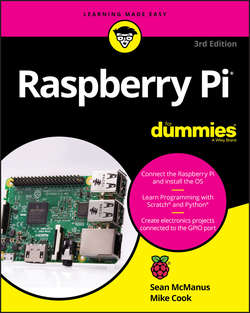Читать книгу Raspberry Pi For Dummies - McManus Sean - Страница 4
На сайте Литреса книга снята с продажи.
Part 1
Setting Up Your Raspberry Pi
Chapter 1
Introducing the Raspberry Pi
ОглавлениеIN THIS CHAPTER
❯❯ Getting up close and personal with the Raspberry Pi
❯❯ Taking stock of your Raspberry Pi
❯❯ Determining its limitations
❯❯ Purchasing your very own Raspberry Pi
❯❯ Figuring out what else you need
The Raspberry Pi is perhaps the most inspiring computer available today. Although most of the computing devices being used (including phones, tablets, and game consoles) are designed to stop people from tinkering with them, the Raspberry Pi is exactly the opposite. From the moment you see its shiny green circuit board, it invites you to prod it, play with it, and create with it. It comes with the tools you need to start creating your own software (or programming), and you can connect your own electronic inventions to it. It’s cheap enough that if you break it, it won’t break the bank, so you can experiment with confidence.
Lots of people are fired up about its potential, and they’re discovering exciting new ways to use it. Dave Akerman (www.daveakerman.com) and friends attached one to a weather balloon and sent it nearly 40 kilometers high to take pictures of the Earth from near space using a webcam. (You can read about Dave’s ballooning project in Chapter 20.)
Professor Simon Cox and his team at the University of Southampton connected 64 Raspberry Pi boards to build an experimental supercomputer, held together by Lego bricks. In the supercomputer (see Figure 1-1), the Raspberry Pis work together to solve a single problem. The project has been able to cut the cost of a supercomputer from millions of dollars to thousands or even hundreds of dollars, making supercomputing much more accessible to schools and students. Others have also experimented with combining the processing power of multiple Pis. There's even an off-the-shelf kit you can use to combine four Raspberry Pi Zeros with a full-size Raspberry Pi (the Cluster HAT from Pimoroni) so that you can experiment with running programs across multiple Pis at the same time.
Courtesy of Simon Cox and Glenn Harris, University of Southampton.
FIGURE 1-1: Two of the Raspberry Pi boards used in the University of Southampton’s supercomputer, with the rest of the supercomputer in the background.
The Pi is also being used to make weather stations, fitness gadgets, gaming devices, audiobook players, electric skateboards, and much more, as you discover in Chapter 20.
Although those projects are grabbing headlines, another story is less visible but more important: the thousands of people of all ages who are taking their first steps in computer science, thanks to the Raspberry Pi.
Both of the authors of this book used computers in the 1980s, when the notion of a home computer first became a reality. Back then, computers were less friendly than they are today. When you switched them on, you were faced with a flashing cursor and had to type something in to get it to do anything. As a result, though, a whole generation grew up knowing at least a little bit about how to give the computer commands, and how to create programs for it. As computers started to use mice and windows, people didn't need those skills any more, and they lost touch with them.
Eben Upton, designer of the Raspberry Pi, noticed the slide in skill levels when he was working at Cambridge University’s computer laboratory in 2006. Students applying to study computer science started to have less experience with programming than students of the past did. Upton and his university colleagues hatched the idea of creating a computer that would come supplied with all the tools needed to program it – and would sell for a target price of $25 (about £20). It had to be able to do other interesting things, too, so that people were drawn to use it, and it had to be robust enough to survive being pushed in and out of school bags hundreds of times.
That idea started a six-year journey that led to the Raspberry Pi you probably have on your desk you as you read this book. It was released in February 2012, and sold half a million units by the end of the quarter. By July 2017, there were more than 14 million Raspberry Pis in homes, schools and workplaces, 10 million of them made in the UK. It is, by a large margin, the best-selling British computer of all time.
